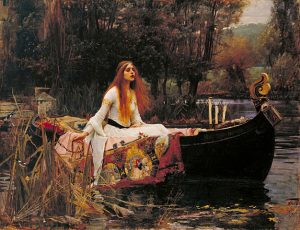
Tennyson said he found this obscure character in a collection of thirteenth century medieval Italian romances under the name “The Lady of Scalot.” This lady pined for the love of Lancelot, for reasons that are unclear, and as she approached her death from lovesickness she asked her father to lay her in an elaborate barge upon the sea with a letter explaining the cause of her demise and denouncing Lancelot as vile, presumably for refusing her love. The unmanned vessel bore her straight to Camelot and King Arthur’s Court. The lords and ladies of the court, along with the Knights of the Round Table, rushed outside the castle to meet the barge, learning through the letter the cause of the unfortunate lady’s death. Tennyson softened her name to Shalott because he felt it sounded more poetic.
This story is recounted in greater detail in Thomas Malory’s fifteenth century Morte d’Arthur, which more people are familiar with, although Tennyson said he was unfamiliar with this work when he published the early version of “The Lady of Shalott.” In this version, a young virgin named Elaine le Blank or Elaine of Astolat encounters SirLancelot making ready to enter a joust and notices that carries no lady’s insignia on his armor. She asks him to affix her emblem to his helmet, which Lancelot gallantly agrees to do. Lancelot wins the joust, and Elaine becomes hopelessly in love. She demands that Lancelot marry her, and when he refuses, she asks to become his paramour. Lancelot refuses, as his love has already been pledged to Guinevere, and Elaine proceeds as outlined in the Italian novella, though this time her barge is set upon the Thames instead of the ocean. After the dead Lady’s vessel moors at Camelot, Lancelot sponsors a Mass for her soul. This inspired Tennyson to add the line where Lancelot asks, “God in his mercy grant her grace” to a later edition of the poem.
Neither the Lady of Scalot nor Elaine of Astolat live in a tower where they weave, nor is the tower on an island, nor are they cursed, nor are they isolated from the rest of humanity, nor are they fairies, nor do they look at mirrors. On the other hand, none of these things are Tennyson’s inventions, exactly. While few would characterize unrequited love as a curse (except perhaps those enthralled by it), people in late medieval and Renaissance times did believe that lovesickness was a serious illness that often caused the death of the lover. Fairy women abound in Arthurian romances, as they do in Celtic mythology, and one of the ways both fairies and mortal women work their magic is through the textile arts. Towers are also found in the Arthurian legends, and knights and kings, as well as ladies, often find themselves imprisoned in these towers. The Isle of Avalon, toward which Arthur embarks as he lays dying, is central to the Arthurian tales.

The original Elaine may have been the siren of Scotland’s Clyde River. There she lived on a rock-built castle on the rock of Dumbarton, staring into a magic mirror in which she could see all that went on in the world – a mirror that has been interpreted to mean the waters itself, whose mirroring surface could be “cracked” by storms. She may be related to the Welsh fairy Elen.
Where “The Lady of Shalott” departs furthest from the mythology that gave rise to the Arthurian legends is in the passivity of the character. The Lady is trapped inside her castle, isolated from the world, compelled to weave scenes of romance but not to participate. Her one self-propelled act is to look away from her mirror, and this results in her death. The Lady epitomizes the Victorian ideal of passive womanhood, the ultimate expression of this being a lingering death that strikes while she is young and beautiful. To quote another poet of Gothic romance, Edgar Allan Poe, “The death, then, of a beautiful woman is, unquestionably, the most poetical topic in the world.”
Here is the poem.
The Lady of Shalott
By Alfred Lord Tennyson
Part I
On either side the river lie
Long fields of barley and of rye,
That clothe the wold and meet the sky;
And thro’ the field the road runs by
To many-tower’d Camelot;
And up and down the people go,
Gazing where the lilies blow
Round an island there below,
The island of Shalott.
Willows whiten, aspens quiver,
Little breezes dusk and shiver
Thro’ the wave that runs for ever
By the island in the river
Flowing down to Camelot.
Four gray walls, and four gray towers,
Overlook a space of flowers,
And the silent isle imbowers
The Lady of Shalott.
By the margin, willow veil’d,
Slide the heavy barges trail’d
By slow horses; and unhail’d
The shallop flitteth silken-sail’d
Skimming down to Camelot:
But who hath seen her wave her hand?
Or at the casement seen her stand?
Or is she known in all the land,
The Lady of Shalott?
Only reapers, reaping early
In among the bearded barley,
Hear a song that echoes cheerly
From the river winding clearly,
Down to tower’d Camelot:
And by the moon the reaper weary,
Piling sheaves in uplands airy,
Listening, whispers ” ‘Tis the fairy
Lady of Shalott.”
Part II
There she weaves by night and day
A magic web with colours gay.
She has heard a whisper say,
A curse is on her if she stay
To look down to Camelot.
She knows not what the curse may be,
And so she weaveth steadily,
And little other care hath she,
The Lady of Shalott.
And moving thro’ a mirror clear
That hangs before her all the year,
Shadows of the world appear.
There she sees the highway near
Winding down to Camelot:
There the river eddy whirls,
And there the surly village-churls,
And the red cloaks of market girls,
Pass onward from Shalott.
Sometimes a troop of damsels glad,
An abbot on an ambling pad,
Sometimes a curly shepherd-lad,
Or long-hair’d page in crimson clad,
Goes by to tower’d Camelot;
And sometimes thro’ the mirror blue
The knights come riding two and two:
She hath no loyal knight and true,
The Lady of Shalott.
But in her web she still delights
To weave the mirror’s magic sights,
For often thro’ the silent nights
A funeral, with plumes and lights
And music, went to Camelot:
Or when the moon was overhead,
Came two young lovers lately wed:
“I am half sick of shadows,” said
The Lady of Shalott.
Part III
A bow-shot from her bower-eaves,
He rode between the barley-sheaves,
The sun came dazzling thro’ the leaves,
And flamed upon the brazen greaves
Of bold Sir Lancelot.
A red-cross knight for ever kneel’d
To a lady in his shield,
That sparkled on the yellow field,
Beside remote Shalott.
The gemmy bridle glitter’d free,
Like to some branch of stars we see
Hung in the golden Galaxy.
The bridle bells rang merrily
As he rode down to Camelot:
And from his blazon’d baldric slung
A mighty silver bugle hung,
And as he rode his armour rung,
Beside remote Shalott.
All in the blue unclouded weather
Thick-jewell’d shone the saddle-leather,
The helmet and the helmet-feather
Burn’d like one burning flame together,
As he rode down to Camelot.
As often thro’ the purple night,
Below the starry clusters bright,
Some bearded meteor, trailing light,
Moves over still Shalott.
His broad clear brow in sunlight glow’d;
On burnish’d hooves his war-horse trode;
From underneath his helmet flow’d
His coal-black curls as on he rode,
As he rode down to Camelot.
From the bank and from the river
He flash’d into the crystal mirror,
“Tirra lirra,” by the river
Sang Sir Lancelot.
She left the web, she left the loom,
She made three paces thro’ the room,
She saw the water-lily bloom,
She saw the helmet and the plume,
She look’d down to Camelot.
Out flew the web and floated wide;
The mirror crack’d from side to side;
“The curse is come upon me,” cried
The Lady of Shalott.
Part IV
In the stormy east-wind straining,
The pale yellow woods were waning,
The broad stream in his banks complaining,
Heavily the low sky raining
Over tower’d Camelot;
Down she came and found a boat
Beneath a willow left afloat,
And round about the prow she wrote
The Lady of Shalott.
And down the river’s dim expanse
Like some bold seër in a trance,
Seeing all his own mischance—
With a glassy countenance
Did she look to Camelot.
And at the closing of the day
She loosed the chain, and down she lay;
The broad stream bore her far away,
The Lady of Shalott.
Lying, robed in snowy white
That loosely flew to left and right—
The leaves upon her falling light—
Thro’ the noises of the night
She floated down to Camelot:
And as the boat-head wound along
The willowy hills and fields among,
They heard her singing her last song,
The Lady of Shalott.
Heard a carol, mournful, holy,
Chanted loudly, chanted lowly,
Till her blood was frozen slowly,
And her eyes were darken’d wholly,
Turn’d to tower’d Camelot.
For ere she reach’d upon the tide
The first house by the water-side,
Singing in her song she died,
The Lady of Shalott.
Under tower and balcony,
By garden-wall and gallery,
A gleaming shape she floated by,
Dead-pale between the houses high,
Silent into Camelot.
Out upon the wharfs they came,
Knight and burgher, lord and dame,
And round the prow they read her name,
The Lady of Shalott.
Who is this? and what is here?
And in the lighted palace near
Died the sound of royal cheer;
And they cross’d themselves for fear,
All the knights at Camelot:
But Lancelot mused a little space;
He said, “She has a lovely face;
God in his mercy lend her grace,
The Lady of Shalott.”
